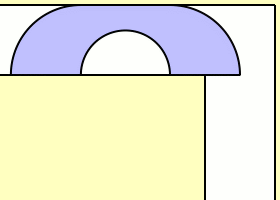Moving sofa problem

The moving sofa problem was formulated by the Austrian-Canadian mathematician Leo Moser in 1966. The problem is a two-dimensional idealisation of real-life furniture moving problems, and asks for the rigid two-dimensional shape of largest area A that can be maneuvered through an L-shaped planar region with legs of unit width. The area A thus obtained is referred to as the sofa constant. The exact value of the sofa constant is an open problem.
Lower and upper bounds
Work has been done on proving that the sofa constant cannot be below or above certain values (lower bounds and upper bounds). One lower bound is . This comes from a sofa that is a half-disk of unit radius, which can rotate in the corner.
John Hammersley derived a lower bound of based on a handset-type shape consisting of two quarter-disks of radius 1 on either side of a 1 by 4/π rectangle from which a half-disk of radius has been removed.[1][2]
Joseph Gerver found a sofa that further increased the lower bound for the sofa constant to approximately .[3][4]
Hammersley also found an upper bound on the sofa constant, showing that it is at most .[5][6]
See also
References
- ^ Croft, Hallard T.; Falconer, Kenneth J.; Guy, Richard K. (1994). Halmos, Paul R. (ed.). Unsolved Problems in Geometry. Problem Books in Mathematics; Unsolved Problems in Intuitive Mathematics. Vol. II. Springer-Verlag. ISBN 978-0-387-97506-1. Retrieved 24 April 2013.
- ^ Moving Sofa Constant by Steven Finch at MathSoft, includes a diagram of Gerver's sofa
- ^ Gerver, Joseph L. (1992). "On Moving a Sofa Around a Corner". Geometriae Dedicata. 42 (3): 267–283. doi:10.1007/BF02414066. ISSN 0046-5755.
- ^ Weisstein, Eric W. "Moving sofa problem". MathWorld.
- ^ Wagner, Neal R. (1976). "The Sofa Problem" (PDF). The American Mathematical Monthly. 83 (3): 188–189. doi:10.2307/2977022. JSTOR 2977022.
- ^ Stewart, Ian (January 2004). Another Fine Math You've Got Me Into... Mineola, N.Y.: Dover Publications. ISBN 0486431819. Retrieved 24 April 2013.





